Celebrity Fish
Our reporter, Leah Docks, went into the wild (actually to home and school aquariums around in Canberra) to interview some interesting and surprising fish. Click on each fish's name to read her reports:
- Boeseman's Rainbowfish
- Zebra Danio
- Blue Three-Spot Gourami
- Tiger Barb
- Buenos Aires Tetra
- Rosy Barb
- Swordtails and Platys
- Kribensis Cichlid
- Waterhouse Snail
Could you interview a fish you know? Have a try and submit it attached to an an email addressed to webmin@cdas.org.au and you could find that you become a published author!
I am a Boeseman's Rainbowfish (scientific name: Melanotaenia boesemani)
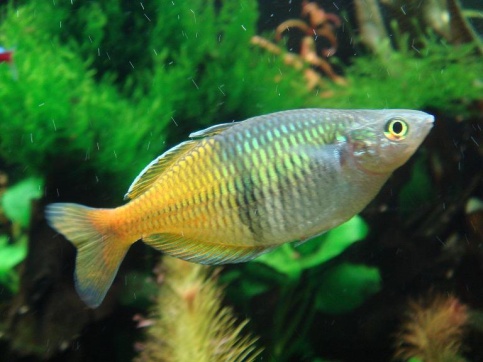
(Image credit: plantedtank.net http://www.plantedtank.net/forums/myFish.php?do=view&p=56)
Where do you come from?
We are beautiful fish from Western New Guinea, Indonesia (also known as Irian Jaya), and have many rainbowfish relatives in Australia. Western New Guinea can be found next to Papua New Guinea, both of which are found on a large island above of Australia. We are mainly found in the Ayamaru/Ajamaru Lakes region of our home country, and love gathering among the aquatic plants. Because of our tropical home, we love regular tropical temperatures of about 26-30C, and a pH a little above neutral. We also like 'hard' water, meaning the water has a nice amount of dissolved minerals and salts (though not as salty as the ocean), but can adapt well to most normal ranges. Our tank carer ensures we have perfect water for our health.
So Mr. Boesemans' Rainbowfish, tell us about yourself:
We are also very popular aquarium fish due to our pretty colours and friendly nature. We are called 'rainbowfish' because of our blue to orange/red colours that run down our bodies, and the way the light shimmers when it reflects off our scales, almost like a real rainbow. Our males are the most colourful, though the females are also very beautiful with less colour but more bright silverly blue on their bodies. One thing that improves our colours is our diet, we love high quality fish food with red krill and shrimp ingredients, as well as green vege-based foods as well as treats of meaty brine shrimp or small worms.
We do hang out in groups of friends, but never cause trouble to the other species which we share out tanks with. We are also active fish, loving to zoom around the middle to top of the aquarium together with others of our kind. We can grow to about 10cm, though the ladies are usually a bit smaller. Will live for about 5 years.
We love swimming around and amongst aquatic plants, and are so happy to be in a real planted tank!
I am a Zebra Danio (scientific name: Danio rerio)
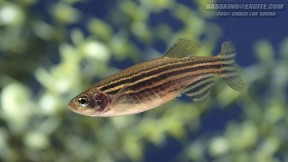
(Image credit: seriouslyfish http://www.seriouslyfish.com/species/danio-rerio/)
Where do you come from?
We are from India! Originally from the Kosi River, a tributary of the famous Ganges River system that runs through the whole country. We can also be found in Pakistan, Nepal, Bhutan, Bangladesh and Myanmar. We are very tough and can cope with a lot of different water conditions and even polluted tanks - though we don't like pollution much and will still get sick if we are kept that way. This is a reason why we are often sold to beginners, we can survive early mistakes fairly well as long as we get good water conditions and a nice big tank in the long term. Because of our hardiness, we will usually adapt well to most any healthy, clean water conditions used for other tropical fish.
If you can stop zipping around for a moment, would you tell us about yourselves?
Well, ok, but only for a moment! We love to swim fast, and though we are only small we really need bigger tanks like this to get the exercise we need, 60L or more is great. We also need friends, so please make sure to have 4 or more of us. If we are alone or in a small tank we will get anxious and lonely, and can start picking on other fish just to give us something to do with all our energy. We love live plants, funny ornaments, driftwood, rocks and other items in our tank to explore and swim though. We are also quite peaceful when we have enough of our own kind to play with, so will usually behave well with others when we are in a group... however our fast speeds might scare some slow moving fish!
We reach 4-5cm in length, and will eat just about any good quality fish food, but watch out if feeding us live food or tasty small foods like small worms or brine shrimp, we go crazy for it! We also like veggies, and cooked peas are a treat that keeps our digestive system healthy. We live about 3 years.
I am a Blue Three-Spot Gourami (scientific name: Trichopodus trichopterus)
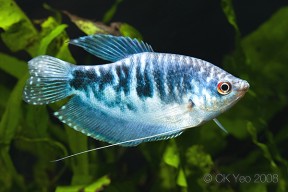
(Image credit: seriouslyfish http://www.seriouslyfish.com/species/trichopodus-trichopterus/)
Where are you from?
Our species comes from Asia, specifically the huge Mekong River basin which branches into China, Vietnam, Laos, Cambodia, Thailand, Myanmar and Malaysia. We are found in slow moving waters which are thick with aquatic plants, including slow moving river tributaries, ponds, large ditches, swamps and marshes. We like slightly acidic to neutral water, but have been bred in the hobby so long we can adapt to most healthy tropical conditions.
Ms. Gourami, exactly how awesome are you?
I'm fairly awesome. I am big, about 12cm, and a beautiful blue, though you can get gold varieties. I also have these neat little 'feelers' beneath my head for sensing the environment around me - my kind likely evolved these as our native river waters can be quite dark and murky, like the colour of tea. However it is not pollution, but the natural decomposition of all the local native plants that colours them this way (just like in a real cup of tea, but not so hot!). Regular floods and tropical rains also stir up mud and silt, so it's handy to have our feelers to guide us. Actually, they are not real feelers like insects have, but actually modified pelvic fins, and all the gourami family have them. Clever aren't we?
We also have cute up-turned mouths for snacking on insects that land on the water, as well as insect larvae that are often found at the surface. We move slowly just like our native waters, and love to gently cruise around a tank and hide amongst the plants. While we are peaceful and frightened of bigger fish (people tapping the aquarium glass), we can sometimes boss around smaller fish in our way, especially if we think they are in our territory. This is why we really need aquariums with space, about 100L minimum, and loads and loads of live plants, and ideally floating plants too. They give us territories we can claim and defend, places to hide, and remind us of our native habitat, the densely plant filled waters of our jungle rivers. I love good quality fish food, live food, meaty treats like brine shrimp and small worms, and also will nibble at algae and any veggies you feed us. If well cared for, we will live 5-7 years.
I am a Tiger Barb (scientific name: Putius tetrazona).
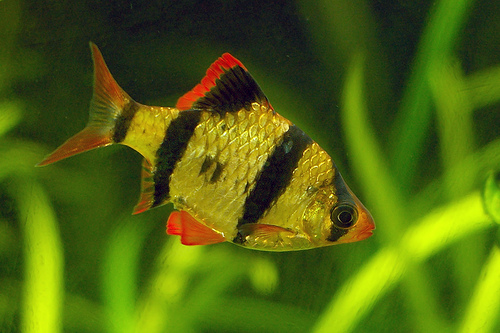
Where do you come from?
My species comes from Asia, and are found across the region, though some of us may have been introduced. Specifically, we are native to the tropical freshwater rivers of the Malay Peninsula, and the Indonesian islands of Sumatra and Borneo. We love rivers, streams, and sometimes swampy marshes with a medium current to swim in and where the water temperature is nice and hot, around 25-30 C. Because our native water chemistry changes a lot between the wet and dry seasons, we are usually able to tolerate a wide range of conditions in aquariums... as long as it is warm and clean of course.
So Ms. Tiger Barb, tell us about yourself:
I am a lively fish with a yellow to gold body and four black vertical stripes. I have orange fins and an orange snout... some people think it looks like I wear lip-stick! I can get as big as 10cm, but in an aquarium I will probably only grow to 5-6cm. We usually live 5 years on average. We are omnivores, that means we like meaty foods as well as some plant matter. In the wild, we get this by eating insects, larvae, snails, worms and small crustaceans which have been eating algae and other plants, so we get our veggies in the bellies of our prey, though we do occasionally nibble on algae too. In the aquarium, we get a mix of flakes and pellets made from different types of meat or plant ingredients, each with the proper vitamins to keep us healthy. We also like to chew on skinned cooked peas and zucchini too. As a special treat, the fish lady brings in frozen small blood worms or brine shrimp when she cleans the tank – what a treat!
I love to hang out in groups of 5 or more friends, where we are always zipping around the middle regions of the tank or just exploring all over. We like shoal, meaning that we like to 'hang out' in a loose group. We also 'school' which means swim together. We have a strong social hierarchy, or 'pecking order', just like chickens or a wolf pack, where the biggest and best fish rule and will occasionally nip the smaller ones to keep them behaving themselves. When there are not enough of us for this, we will often pick on other slower fish... so it's important that the fish lady keeps lots of friends for us to play with so we can spend our time chasing each other and not the other species.
More Info: http://wereallwet.com/tiger-barb-care/
I am a Buenos Aires Tetra (scientific name Hyphessobrycon anisitsi )
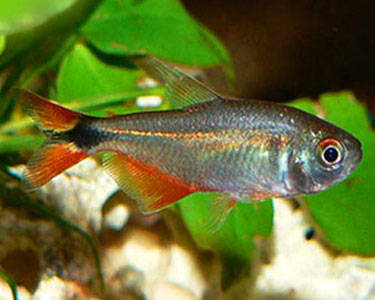
Where do you come from?
Can you guess? It’s Buenos Aires! That is a city in South America, in the country called Argentina. Of course we don’t live in the city though, we are found in the Parana and Uruguay Rivers which are in the area. We are a tough little fish, and can adapt to a lot of conditions, and can deal with colder temperatures than most other tropical fish... but not too cold. As long as our water is kept over 17 C and clean, we will be very happy.
So Mr. Buenos Aires Tetra, tell us about yourself:
We love to exercise and play rough! In fact, we spend almost all day actively swimming around our tank and chasing others in our shoal, so even though we are small we still need a big tank to play in and to house all our other Buenos Aires tetra friends. It’s very important to keep us with friends of the same species so we can play and keep a pecking order (just like the tiger barbs, where the bigger fish rule the smaller ones). If there are not enough in our group we can get anxious and start to chase and bite other fish, something our friends don’t mind but other fish won’t like very much.
We can grow to a nice size for a member of the tetra fish family, up to 7cm. We are silvery on our sides, though if you look closely we almost have a rainbow sheen to our sides. We also have red fins, and a nice black diamond on our caudal fin (tail), which is edged in yellow. When we are happy, our colours really shine. We are also known for snacking on aquarium plants... good thing the fish lady has lots in our tank, hopefully there will be more than we can eat! We are omnivores though and so also like meaty foods. A good quality fish food every day including both meat and plant ingredients, and occasional meaty treats (like brine shrimp, krill or blood worms) will keep us in top health. We should live about 5 years if kept fit and healthy.
More Info: http://www.aquariumdomain.com/viewSpeciesFreshwater.php?id=126#
I am a Rosy Barb (scientific name: Puntius conchonius).
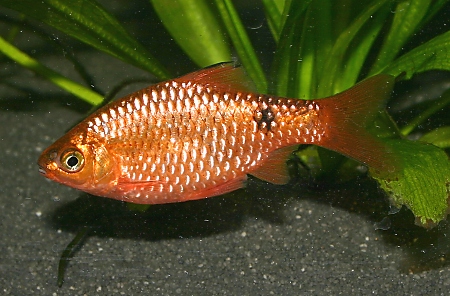
Where do you come from?
I come from India near Bengal, and can also be found in Pakistan, Afghanistan and the more sub-tropical areas of Nepal. We can adapt from soft to hard (salty) water, and a varied pH. We will also cope well with cooler temperature than most fish, and actually like it a bit cooler than most, around 18 – 22 C, though we adapt to a bit warmer (the Hawker tank is set at a stable 24 C, which is fine for us).
Please tell me more Mrs. Rosy Barb:
Because we are so tough, active and peaceful when in a group, we are often used as ‘beginner fishes’ as we will usually survive mistakes of people just learning about fish care.
However many fish keepers will stay with us simply because we are so easy to keep, and because we are able to get along with most other fish as we can usually adapt to their needs and will not bother them, or be pushed around either. We like to swim in the middle to bottom half of the tank, and so we’re a good choice for adding some colour and life to this area, especially if there are territorial fish who have claimed the top of the tank or the big open swimming spaces. Though often sold as small yellow fish with a little black dot on our tail, we will grow to become rosy red and quite large – up to 14cm! The men are usually brighter red than the ladies, who are rounder in the belly. As we really need to have 5 or so friends around to stay happy, we can quickly crowd a small tank, and so are better in large tanks where we can grow to our full size and beauty.
We are omnivores who eat anything from tiny bugs, worms and crusteceans to dead plant matter and algae. In fact we are handy for cleaning some types of hairy algae away from wood, plants and decoration entirely, which means less cleaning of the tank and a special healthy treat for us too! In the aquarium, we love to eat good quality fish food plus some treats of meaty worms or brine shrimp, and plant treats of algae food wafers, peas or spinach to keep us healthy and our colours beautiful.
More Info: http://tlca.in/species_profile/rosy_barb-fw-fish
We are Swordtails and Platys. We look a little similar, but are two separate species. If I have a long part extending from my tail, I am a male swordtail (scientific name: Xiphophorus hellerii ). If my tail is short and rounded, I am a platy (scientific name: Xiphophorus maculatus), or a female swordtail. We are a different species, but look similar and can interbreed to create hybrids (a mix of both species).
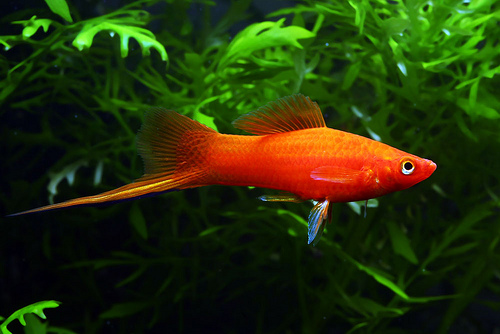
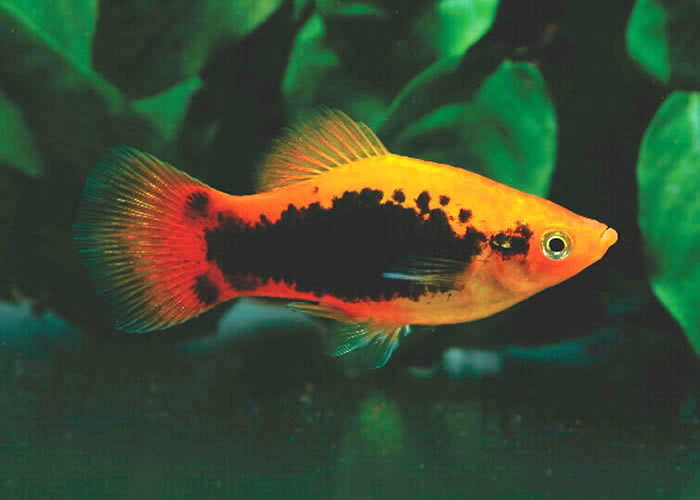
Where do you come from?
Our species come from Central America, and can be found all the way from Mexico and Veracruz, though to Belize and Guatemala. We live among water plants and love swimming in slow to moderate currents of fresh water rivers. We are also found in rivers where the water gets a bit salty, though not as salty as the ocean - a type of water called ‘brackish’. We need warm water, but because we can adapt to rivers from fresh to brackish, we can live in many types of water pH and hardness (which means saltiness). Still, in the aquarium we prefer the pH just a bit above neutral and a bit of salt added to keep us in perfect health (the fish lady does this for us). It also needs to be warm (over 20 C) and nice and clean. It is interesting that our wild relatives are not as colourful as we are – it’s taken a lot of breeding by fish keepers in the aquarium hobby to produce our amazing colours and patterns.
So, what’s so cool about you guys?
Plenty! Firstly we come in LOTS of bright colours, everything from orange, yellow, pink, red, white, black, and even dark blue or emerald green. We also come spotted, with different coloured fins, bodies and bellies, and even a platy type with a ‘Mickey Mouse’ head shape on the tail! The male swordtails also have a long bottom part (a ‘ray’) on our caudal fin (tail fin) which sticks out and can look very cool with a neat stripe. Our species also differ in size, platys get between 5-6cm, and swordtails between 14-16cm long. In both cases the girls are bigger than the boys and quite round in the belly. We work well in an aquarium with lots of different species because we are big enough and fast enough not to be picked on by any nippy schooling fish, but also very peaceful so we can hang out with the quieter species. We just get along with everyone. We also don’t really get territorial either, so we swim all over and are very playful, making a great display – especially if there are plants to play in. We will also be happy alone as a single ‘feature fish’ (though we do like playmates) or in a big group of friends and family. We all have our own personalities too.
One thing we are famous for is making a bit more waste than the little fish, so our owners have to be careful not to put too many of us in a small tank which would make it dirty and poisonous faster. We are also famous as being part of a group of fish known as ‘live bearers’, which means we don’t lay eggs, we give birth to live babies. Just like humans, the ladies get very large bellies before they give birth. We usually have a big group of kids, who look just like little adults. Platies will live about 3 years, swordtails about 5 years.
We are omnivores and like both meat and plants, though we won’t eat live plants in an aquarium, but might nibble algae or brown leaves, which is always helpful! We love nice fish food made from meat and plants, as well as some extra veggies like special algae filled fish wafers, or even cooked and skinned peas or zucchini from home– yum!
I am a Kribensis Cichlid, or 'krib' for short (scientific name: Pelvicachromis pulcher)
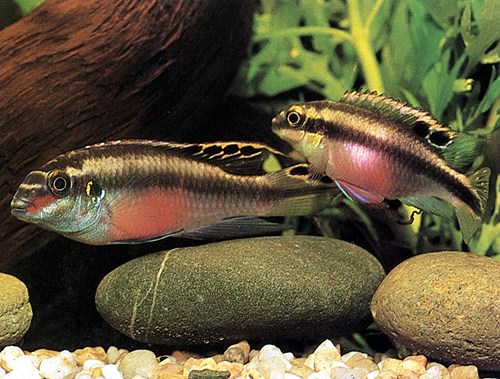
Where do you come from?
We kribensis cichlids come from Africa. We are found in the central west of the continent, mainly in the Niger River delta (a delta is a big branching river system) in Nigeria, and we are also found in fresh waters of coastal Cameroon. Waters here vary from 'hard' and salty near the sea, to 'soft' (which means very few salts or minerals), and from high to low pH. This makes us very adaptable in the aquarium, though we prefer the soft and neutral to slightly acidic (lower pH) waters similar to our normal wild habitat. Our waters are tropical, 24 -26 C, and we like both fast and slow moving streams and rivers, as long as there is a lot of underwater plant life to hide in.
So Mr and Mrs Krib, tell us about yourselves:
We like to think we are a very pretty fish! Mr Krib is bigger and might grow to 10cm, has a pointed end on his dorsal fin (the fin on his back), and has a longer caudal fin (tail fin) than his wife. Mrs Krib is smaller, growing about 8cm, though fatter and has a rounded end on her dorsal fin and a shorter caudal fin. Mrs Krib also has brighter colours, especially when full of eggs. We both have a yellow and a dark chocolate stripe across our bodies, brown and yellow fins, and our dorsal and caudal fins have dark spots ringed in gold. Some say our best feature is our belly, which is a dark pink or purple in colour. When ready to spawn (which means breed and lay our eggs), our bellies will turn bright purple or even cherry red – especially Mrs Krib, so keep an eye on us!
If we do have some babies, you'll see that we, like many cichlid species, are excellent parents. In the wild we love to dig little burrows or find natural caves to breed in, and this becomes our home and territory. When the eggs hatch, Mrs Krib will stay with the kids while Mr Krib guards the home. He will chase or nip any fish who comes close to our family, what a great Dad. When the kids are old enough (7-10 days old), you will see Mrs Krib taking our babies for little 'excursions' around the tank when she thinks it's safe. If scared, they will all run back to the cave, so keep your distance and watch quietly if you see the family out and about.
We will live about 5 years on average. Being omnivorous, we will take most foods made from meat and plants. In the wild, we love algae as a veggie, so will eat most of the foods served to the rest of the tank. You may also see us nibbling at leaves and the brown algae on the rocks and glass from time to time.
I am a Waterhouse Snail (scientific name: Notopala waterhousei ).
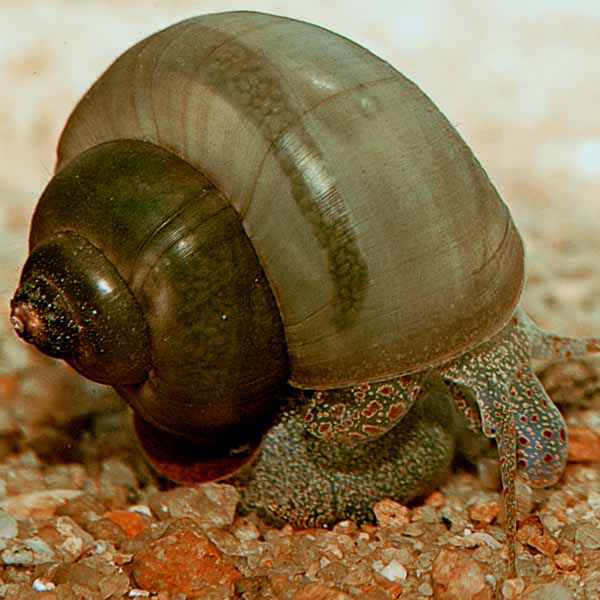
image credit: Aquagreen
Where do you come from?
I am an Australian native! I came all the way from Darwin at the far northern top of Australia in the Northern Territory, though in the wild I live in the central part of the NT and can also be found in western Queensland. I like warm water and am pretty adaptable, though I like a little salt as the calcium helps me build my shell (luckily, the fish lady adds some for me). I grew up in a pond in Darwin, and I few on a big plane just to be here at Hawker!
So, what’s so interesting about a snail?
I beg your pardon, there are lots of interesting things about me! For starters, I am Australia’s BIGGEST fresh water snail - I can grow almost as big as a golf ball. While not as colourful as the fish, I do have a nice cream, grey and olive colours on my shell. And if you look closely at my foot and head (otherwise known as my squishy parts), you'll see it is grey with tiny pink spots! I am important as the janitor of the tank. I like to eat ‘periphyton’ which is a fancy term for the mix of bacteria, algae, and slime that naturally grows on the plants, rocks and glass. I also love detritus (all the gunk at the bottom), dead plants, and left over fish food. If you see me on the glass have a close look at my mouth, it's like a long tube with a little hole. Inside I have a funny tongue with backwards pointed parts, like a cheese grater. It is called a ‘radula’. You might be able to see me using this to rasp off algae and slime from glass, rocks and plants as I lick them. The great thing about me is that I don’t eat live plants, only the dead parts, as well as the stuff no-one else in the tank likes, as well as the gunk that makes it dirty. The fish lady loves the help I give her in keeping the tank clean!
Copyright Leah Docks 2014
